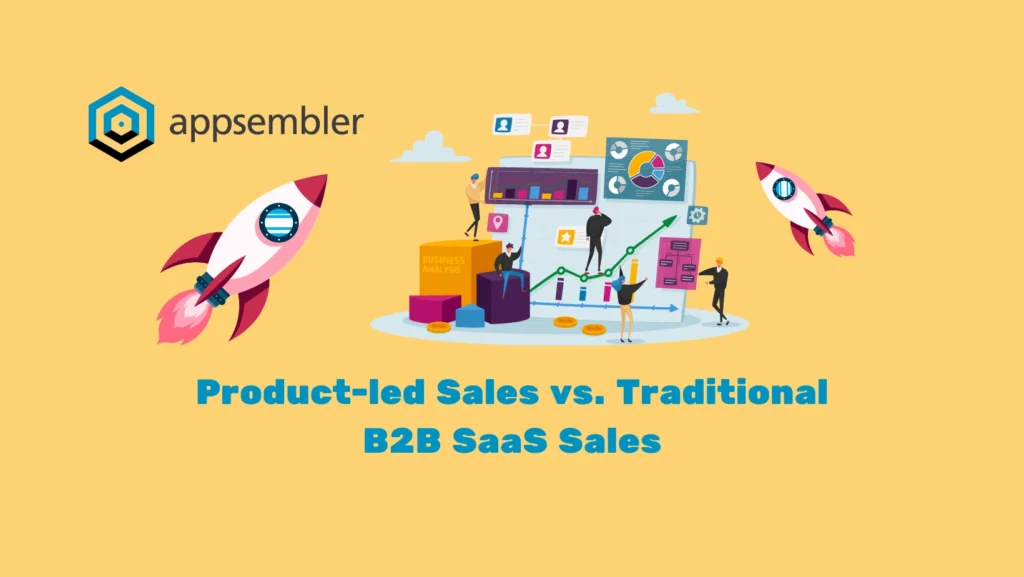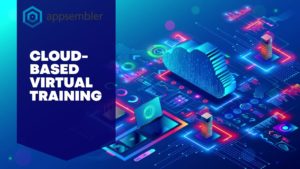Discover the fundamental differences between Product-led Sales vs Traditional B2B SaaS Sales in our comprehensive guide. As the SaaS industry experiences rapid growth, understanding these two distinct approaches is crucial for businesses seeking sustainable success. In this article, we will explore the core principles of each approach, compare their customer acquisition strategies, and highlight the unique challenges and considerations associated with adopting a product-led sales model.
Key Takeaways
- Product-led Sales emphasizes self-service and free trial-driven customer acquisition, while traditional B2B SaaS Sales relies on sales team-driven interactions.
- Product-led companies focus on intuitive onboarding experiences and in-app engagements, while Traditional SaaS companies offer personalized onboarding and account management.
- Product-led companies focus on intuitive onboarding experiences and in-app engagements, while Traditional SaaS companies offer personalized onboarding and account management.
- Pricing models differ, with Product-led Sales adopting freemium and usage-based pricing, while Traditional SaaS follows enterprise-level and fixed pricing.
- Key metrics for Product-led Sales include adoption rates and product usage analytics, while Traditional SaaS focuses on revenue-driven metrics and sales quotas.
- Companies transitioning to a product-led approach must consider challenges related to company culture, sales and marketing alignment, and measuring ROI.
Introduction
In this digital age of rapid technological advancements, software-as-a-service (SaaS) companies have become the driving force behind innovation across various industries. Within the realm of SaaS, two prominent sales strategies have emerged – Product-led Sales and Traditional B2B SaaS Sales. Understanding the nuances and differences between these approaches is essential for businesses seeking sustainable growth and success in a competitive market.
Understanding Product-led Sales
Understanding and Core Principles of Product-led Sales
At its core, Product-led Sales is a strategy that revolves around the product itself as the primary driver of customer acquisition and conversion. It entails offering a self-service product experience, allowing potential customers to explore and understand the product’s value independently. The goal is to create a seamless and delightful user experience that fosters organic growth through customer satisfaction.
Benefits of a Product-led Approach for SaaS Companies
The product-led approach offers several advantages for SaaS companies. Firstly, it aligns perfectly with the preferences of modern buyers who prefer to self-educate before making purchasing decisions. Secondly, it enables businesses to reach a broader audience, including individual users and small teams, without the need for a dedicated sales team. Lastly, it facilitates rapid user adoption and higher customer retention rates by delivering value upfront.
Exploring Traditional B2B SaaS Sales
Definition and Characteristics of Traditional B2B SaaS Sales
In contrast to the product-led approach, Traditional B2B SaaS Sales relies heavily on a dedicated sales team to drive customer acquisition and conversions. This sales model involves personalized interactions between sales representatives and potential customers, often through demos, presentations, and negotiations. The focus is on building strong relationships and understanding the unique needs of each prospect.
Advantages and Limitations of the Traditional Sales Model
The traditional sales model has long been a tried-and-tested approach, offering certain advantages, such as a highly personalized sales experience and the ability to address complex enterprise requirements effectively. However, it also has limitations, including high customer acquisition costs and longer sales cycles.
Key Differences between Product-led Sales vs Traditional B2B SaaS Sales
Customer Acquisition Process
- Product-led: In a product-led approach, the customer acquisition process is primarily self-service and freemium-driven. Prospective customers can sign up for free trials or explore the product’s features before committing to a purchase.
- Traditional: In the traditional model, the customer acquisition process is sales team-driven. Sales representatives play a critical role in reaching out to potential customers, understanding their needs, and guiding them through the sales funnel.
User Onboarding and Activation
- Product-led: Product-led companies prioritize providing a seamless and intuitive onboarding experience. The focus is on enabling users to quickly understand and utilize the product’s core features without the need for extensive training.
- Traditional: Traditional B2B SaaS companies often offer personalized onboarding with the assistance of a dedicated sales representative. This process involves detailed training and support to ensure customers can maximize the value of the product.
Customer Engagement and Retention
- Product-led: Product-led companies heavily invest in in-app engagements, proactive customer support, and regular product updates to keep users engaged and satisfied. Customer success resources are readily available to guide users towards achieving their desired outcomes.
- Traditional: In the traditional model, customer engagement and retention are typically managed through dedicated account managers. These managers conduct periodic check-ins and ensure contract renewals, focusing on the long-term relationship with the customer.
Pricing Models
- Product-led: Product-led companies often adopt flexible pricing models, such as freemium, tiered pricing, or usage-based pricing. This approach allows customers to start with a free version and upgrade as per their needs.
- Traditional: Traditional B2B SaaS companies usually offer enterprise-level pricing with fixed plans or custom packages. Negotiations with sales representatives are common to determine the best fit for the customer’s requirements.
Sales Metrics and KPIs
- Product-led: In the product-led approach, sales metrics revolve around adoption rates, conversion rates, and product usage analytics. These metrics provide insights into how effectively the product is driving growth.
- Traditional: In the traditional sales model, revenue-focused metrics, sales quotas, and deal closure rates are the primary KPIs. The emphasis is on measuring revenue generated from sales efforts.
Challenges and Considerations for Adopting Product-led Sales
Adapting Company Culture
Transitioning to a product-led sales approach requires a fundamental shift in company culture. It entails embracing a customer-centric mindset, where product excellence, customer satisfaction, and user feedback take center stage.
Aligning Sales and Marketing Teams
In a product-led sales model, collaboration between sales and marketing teams is crucial. Both teams must work together to craft compelling messaging and ensure a seamless user experience throughout the customer journey.
Measuring ROI and Success
Measuring the ROI of a product-led sales strategy requires careful consideration of various metrics, such as customer acquisition costs, user engagement, and customer lifetime value. Success metrics may differ significantly from those used in the traditional sales model.
Case Study: Appsembler – Revolutionizing Product-led Sales in the SaaS Industry
Appsembler, a leading online learning platform, is an exemplary case of successful product-led sales implementation. The company focuses on empowering its users to create engaging online courses and learning experiences.
How Appsembler Implemented Product-led Sales
Appsembler embraced a product-led approach by offering a free trial version of its platform, allowing potential customers to experience the platform’s capabilities firsthand. The company invested in comprehensive product documentation and customer success resources to ensure seamless onboarding and user activation.
Results and Impact on Business Growth
Through its product-led sales strategy, Appsembler witnessed substantial growth in user adoption and customer retention. The free trial approach led to increased conversions, while the in-app engagements fostered stronger customer relationships.
Best Practices for Transitioning to a Product-led Sales Approach
Identifying the Right Product-led Strategy
Choosing the right product-led sales strategy is critical for success. Businesses should carefully assess the nature of their product, target audience, and market dynamics to determine the most suitable approach. They can consider factors such as the complexity of the product, the potential for self-service onboarding, and the value that users can derive from a free version.
Implementing Product-led Sales Tools
To effectively execute a product-led sales strategy, companies must invest in the right tools and technologies. These may include user analytics platforms to track user behavior and engagement, in-app messaging systems for proactive customer support, and customer success platforms for personalized user guidance.
Nurturing a Product-led Sales Culture
Creating a product-led sales culture involves instilling a customer-centric mindset throughout the organization. Employees must prioritize understanding customer needs and delivering value through the product. Companies can foster this culture through ongoing training, customer-centric KPIs, and cross-functional collaboration.
Conclusion
In the ever-changing landscape of the SaaS industry, understanding the differences between Product-led Sales vs Traditional B2B SaaS Sales is crucial for companies seeking sustainable growth and success. Product-led Sales, with its emphasis on customer-centricity and self-service experiences, has revolutionized the way SaaS companies approach customer acquisition and engagement. On the other hand, the Traditional B2B SaaS Sales model remains a viable option for businesses that cater to complex enterprise requirements and prefer personalized interactions.
As the software industry continues to evolve, it is essential for SaaS companies to evaluate their unique needs, product offerings, and target audience to determine the most suitable sales strategy. Whether it’s adopting a product-led approach, sticking to traditional sales methods, or finding a hybrid solution, the key lies in understanding and catering to the preferences of the modern digital-savvy buyers.
Frequently Asked Questions
The product-led approach offers several advantages, including reaching a broader audience, rapid user adoption, and higher customer retention rates. It aligns with modern buyers’ preferences for self-education and provides a seamless user experience.
Product-led Sales refers specifically to the sales strategy centered around the product, while Product-led Growth encompasses a more holistic approach involving product, marketing, and customer success efforts to drive growth.
Yes, a product-led approach allows SaaS companies to achieve success without a traditional sales team. By offering a self-service experience and providing value upfront, companies can attract and convert customers organically.
Balancing freemium and premium offerings involves understanding customer segmentation and needs. Offering a limited but valuable free version can attract users, while premium plans cater to power users with additional features and benefits.
While product-led sales offer significant advantages, it may not be suitable for complex products or enterprise-level solutions that require personalized interactions and extensive support.
Customer education is critical in a product-led sales approach. Providing comprehensive product documentation, tutorials, and in-app guidance empowers users to derive maximum value from the product independently.
SaaS companies can optimize onboarding by offering a simple, intuitive, and interactive onboarding experience. User onboarding emails, in-app tutorials, and guided product tours can help users understand the product’s value quickly.
SaaS products with a user-friendly interface, quick time-to-value, and the potential for self-service onboarding are best suited for a product-led sales strategy. These products can showcase their value to users immediately.
Essential tools for implementing a product-led sales approach include user analytics platforms, in-app messaging systems, customer success platforms, and customer support tools. These tools facilitate user engagement and support throughout the customer journey.
Key metrics for measuring a product-led strategy’s success include adoption rates, conversion rates, product usage analytics, and customer retention rates. These metrics provide insights into how effectively the product drives growth.



